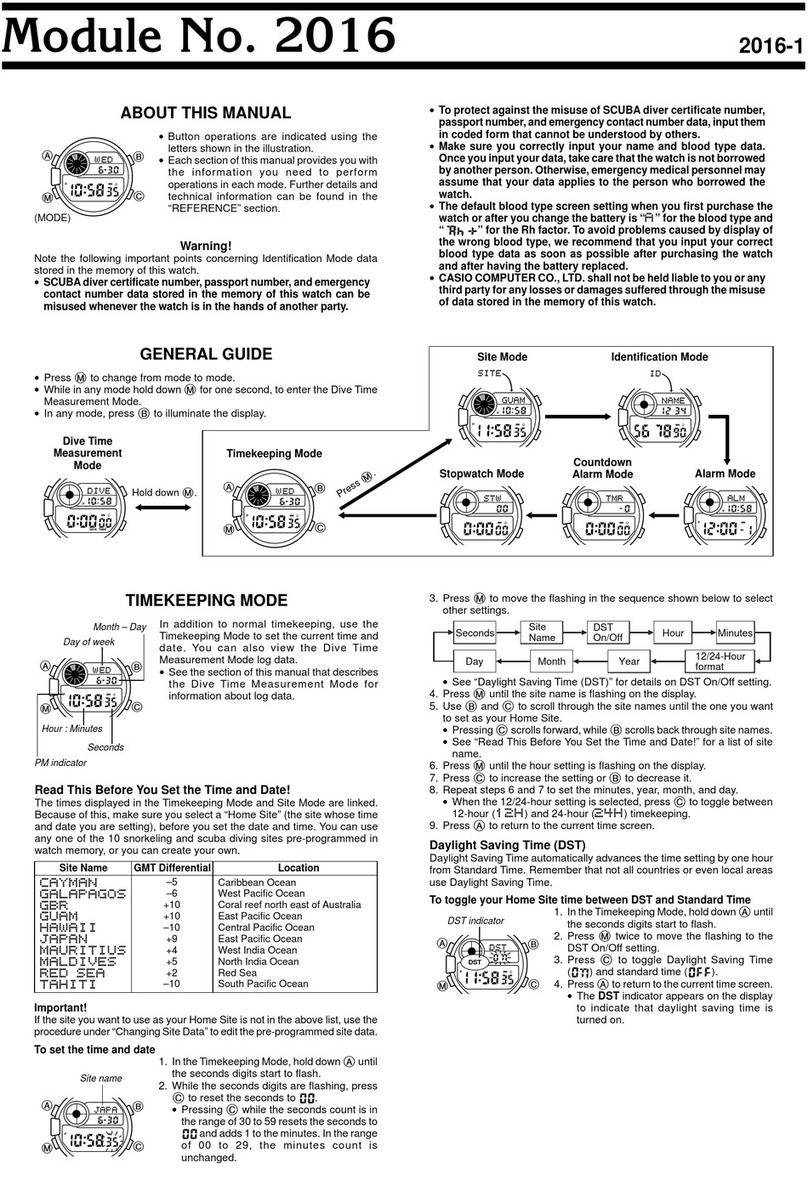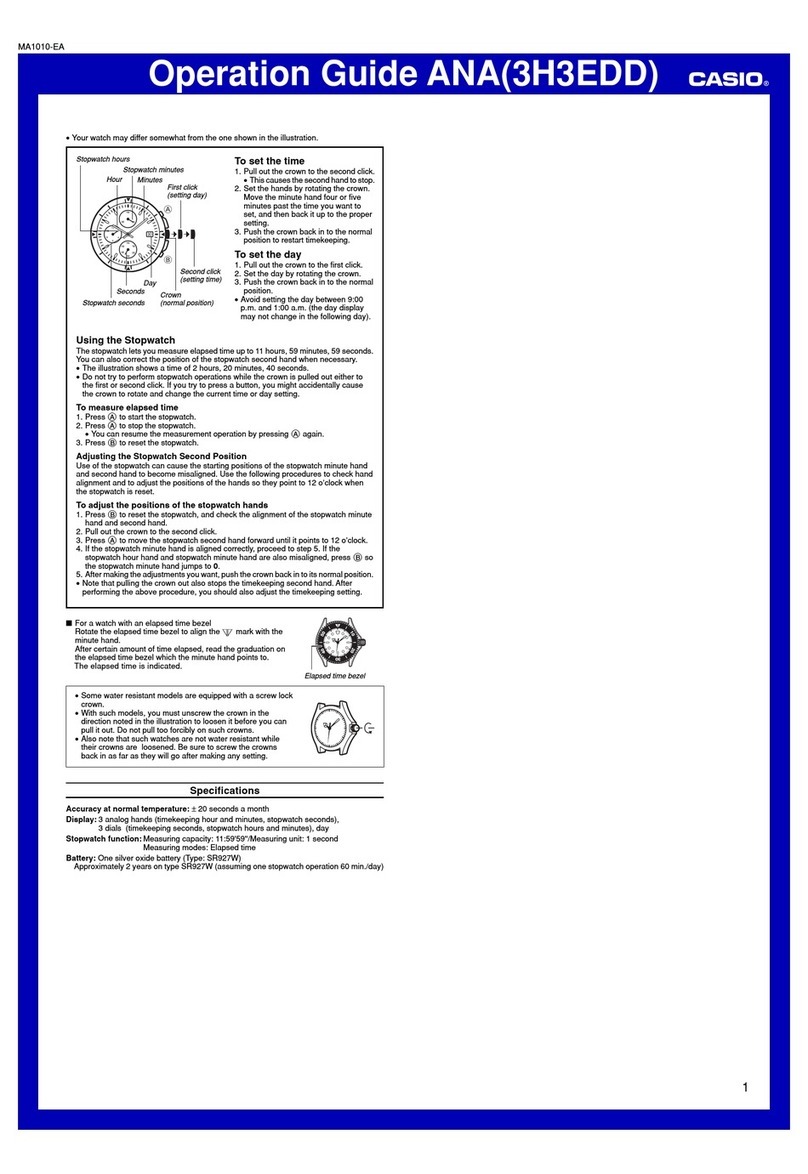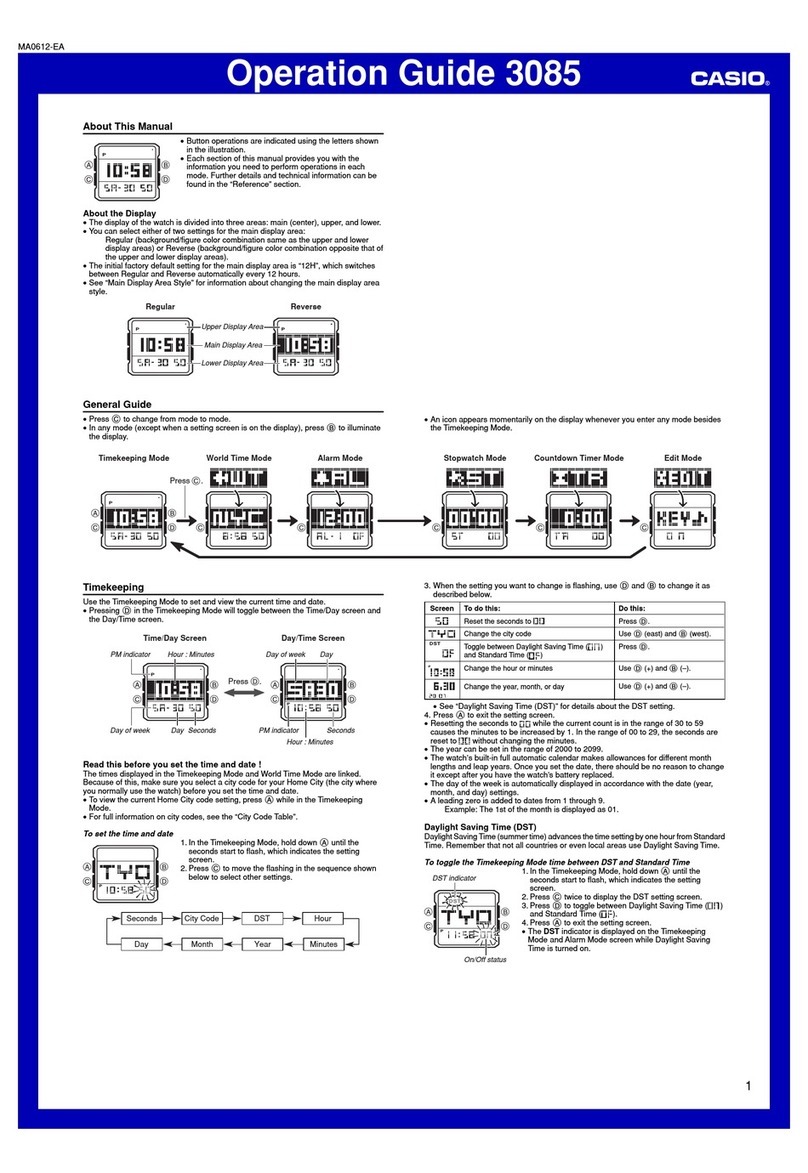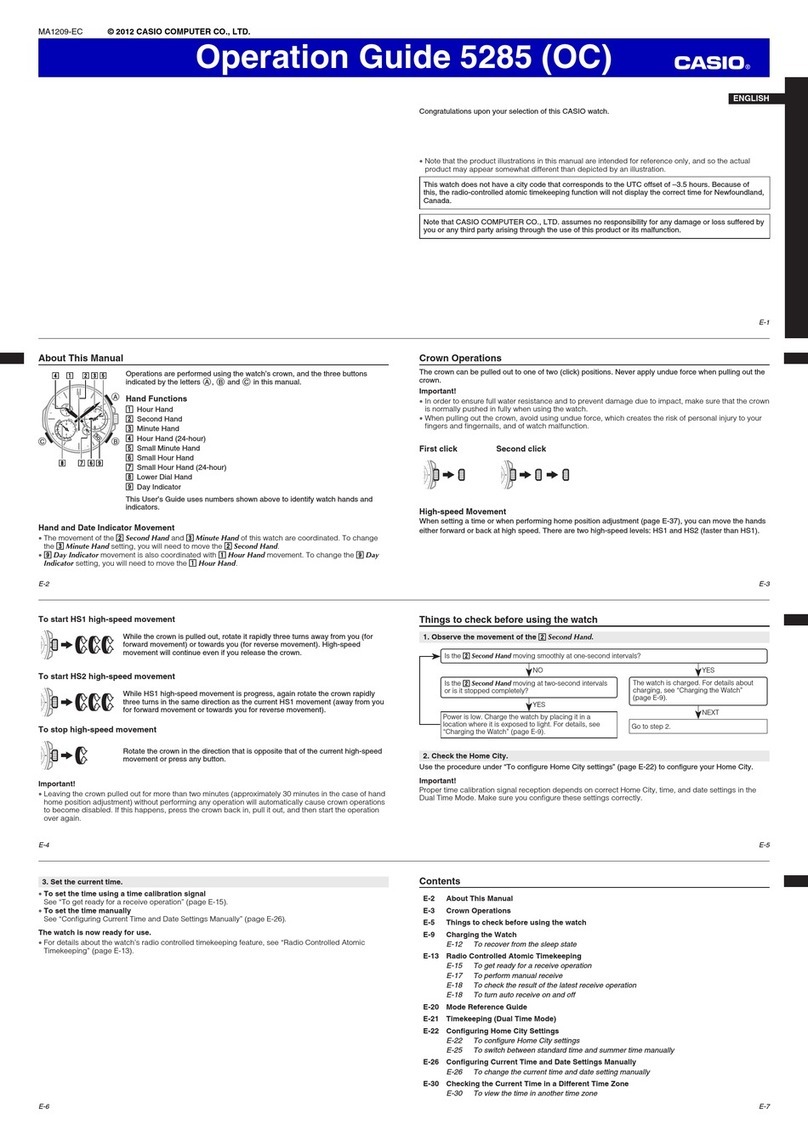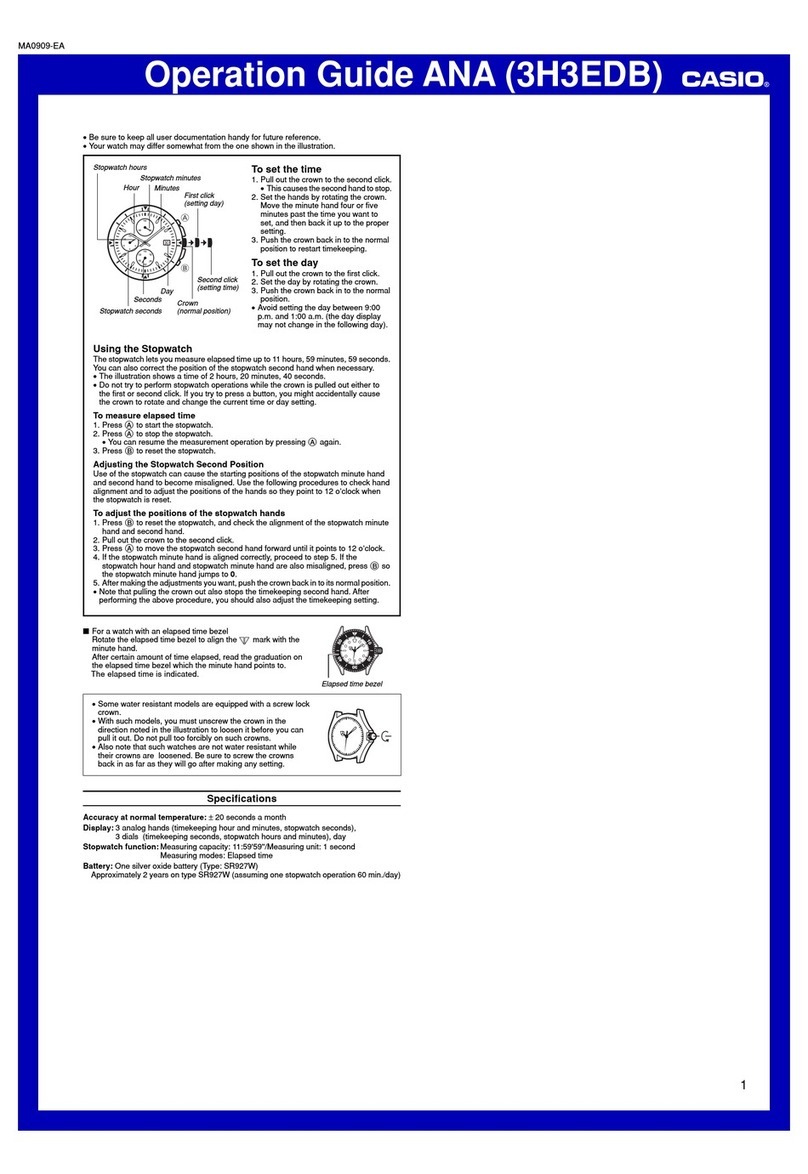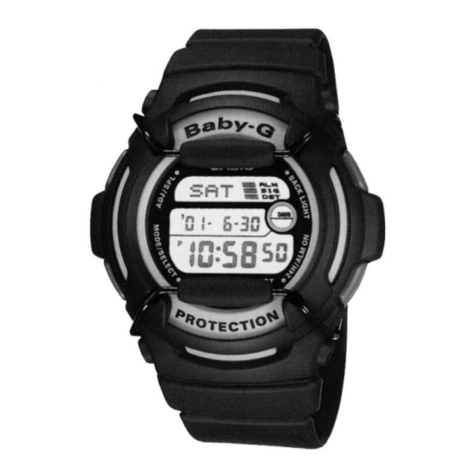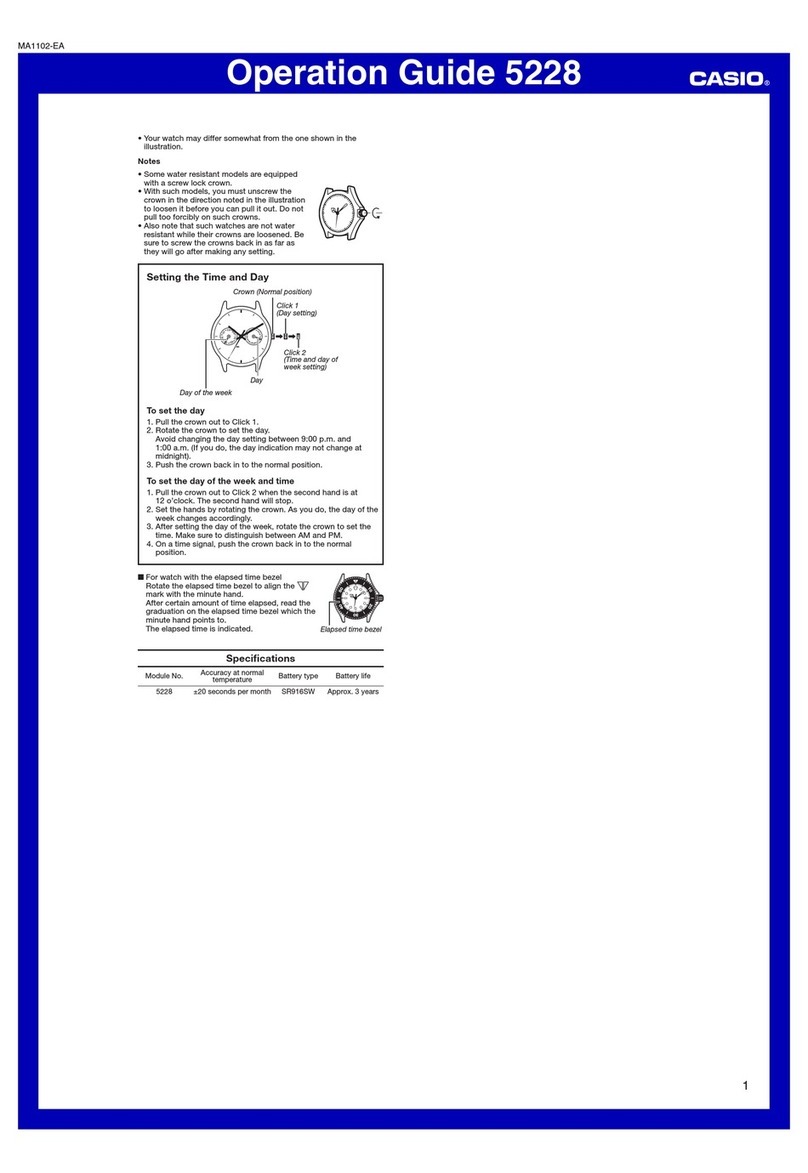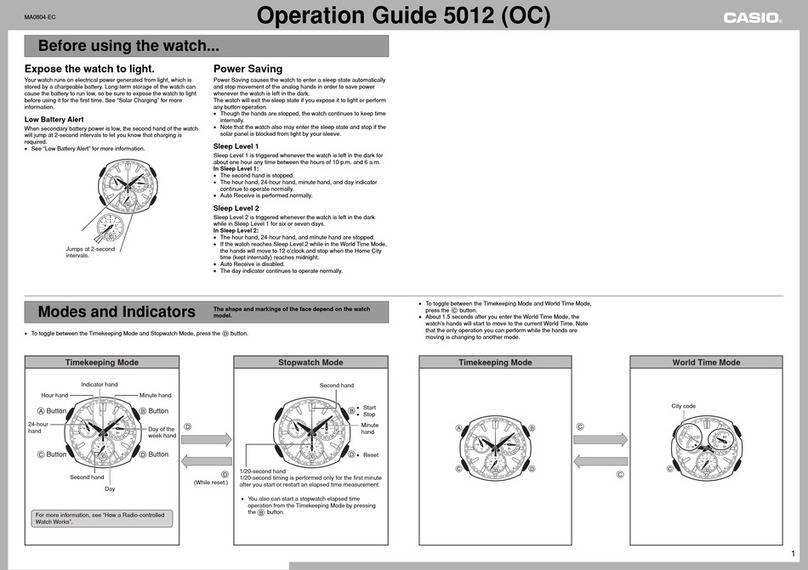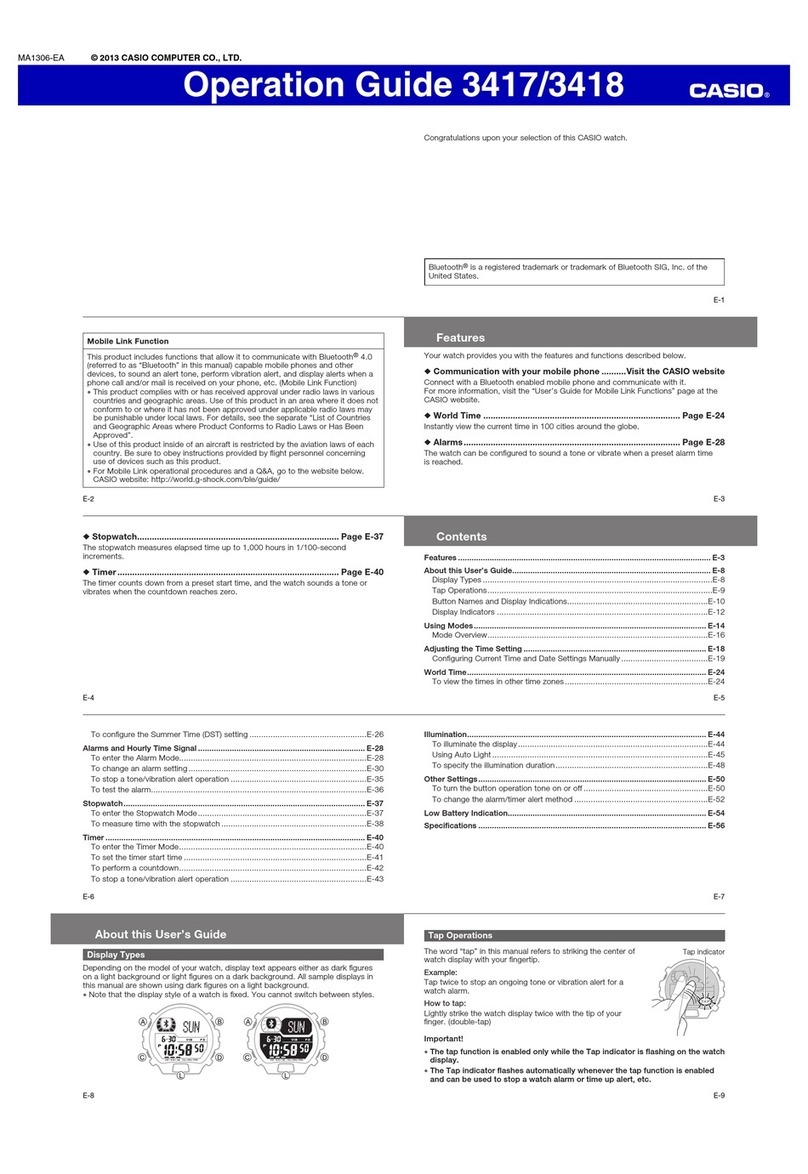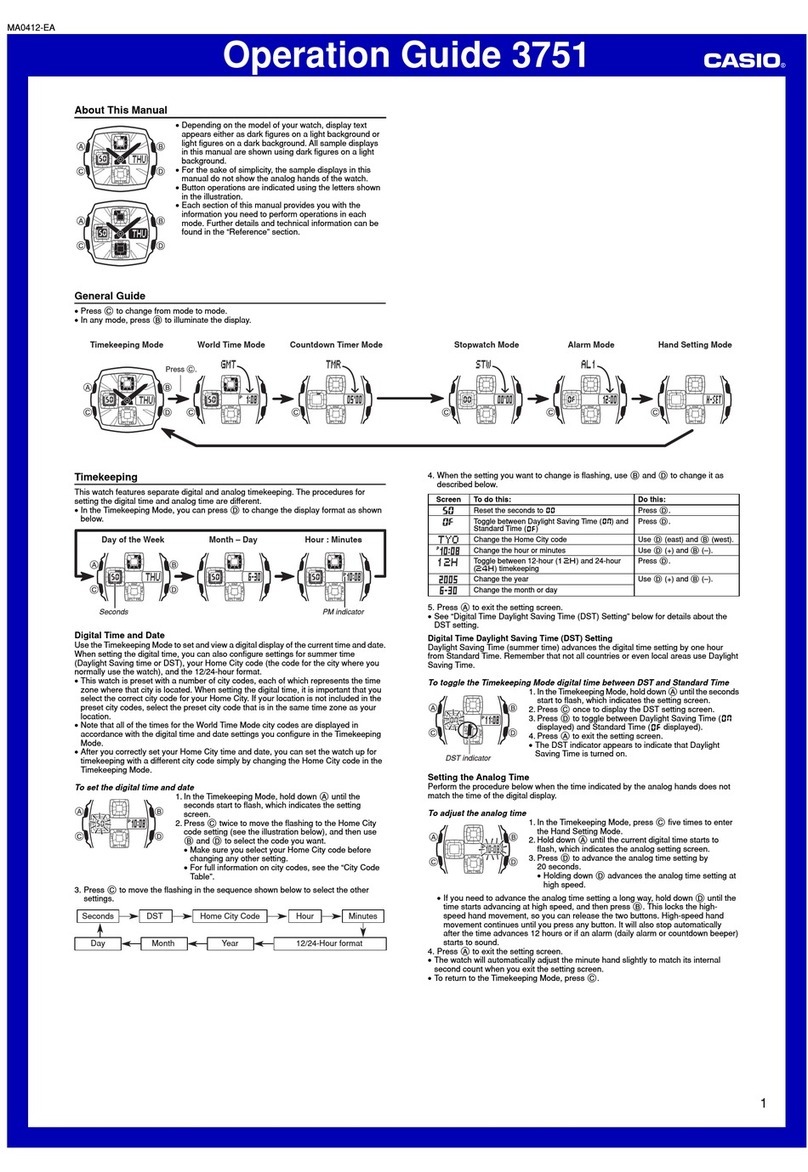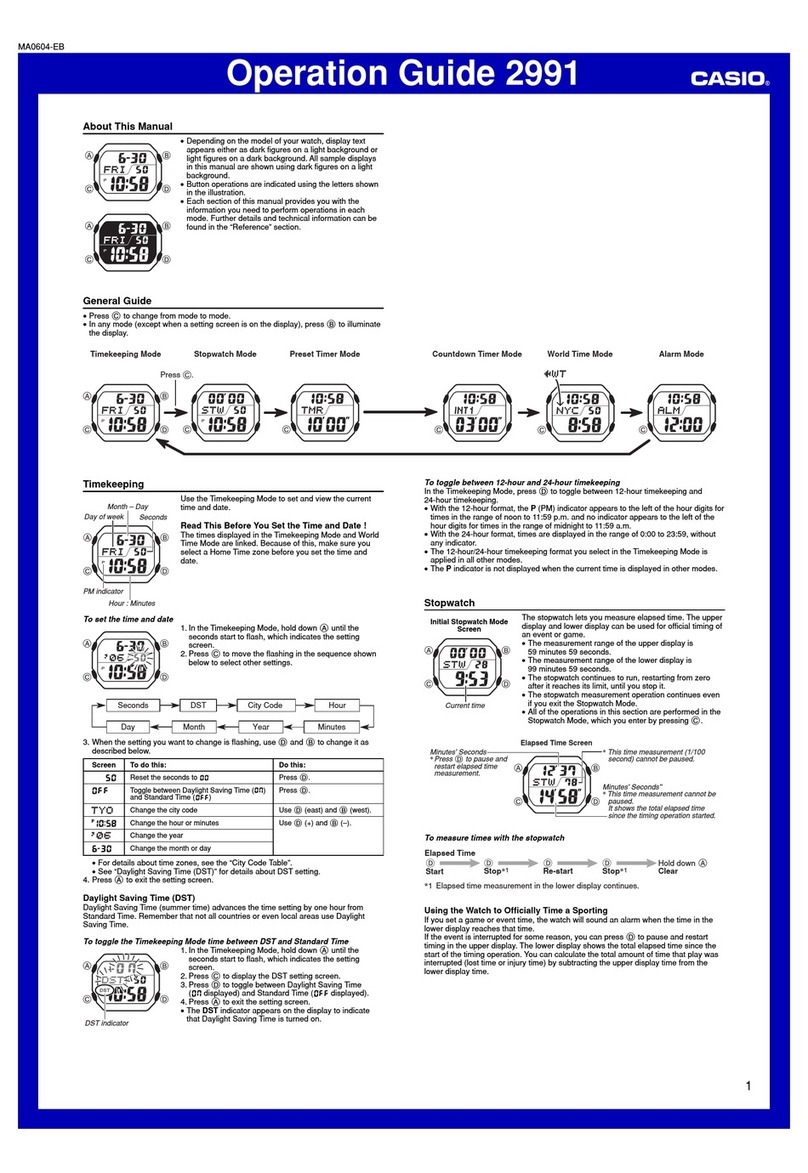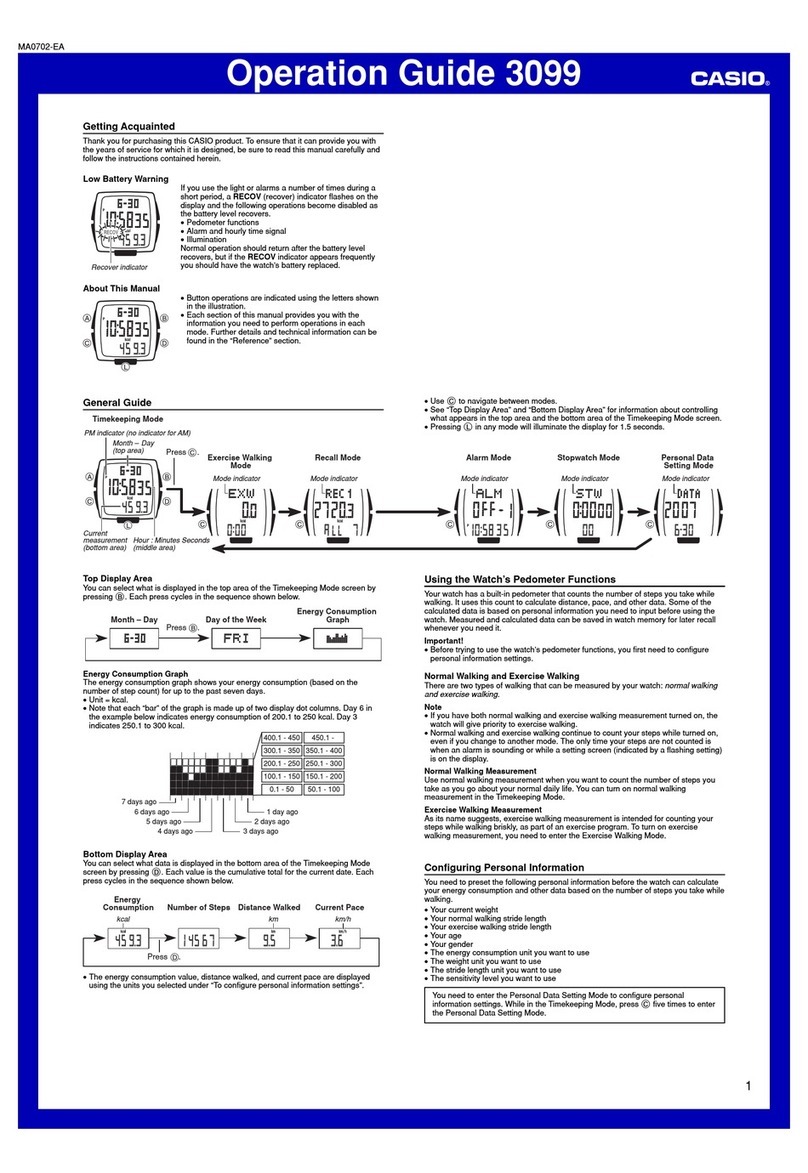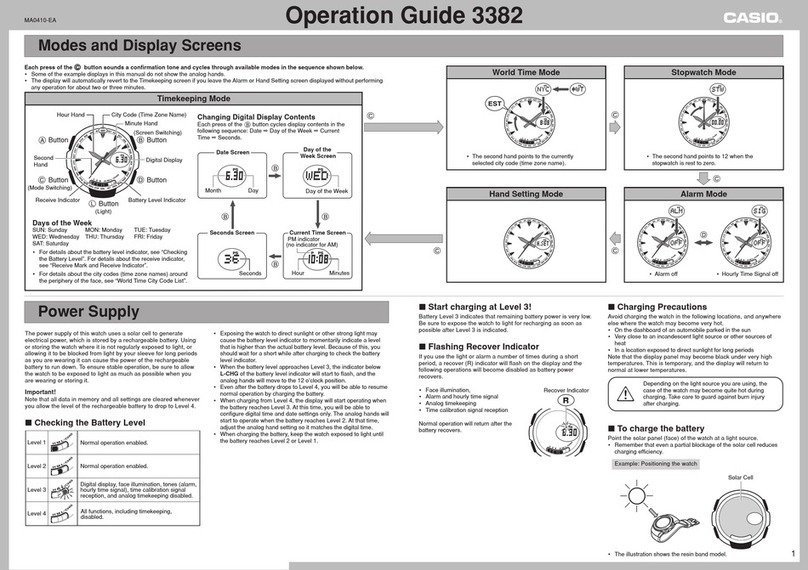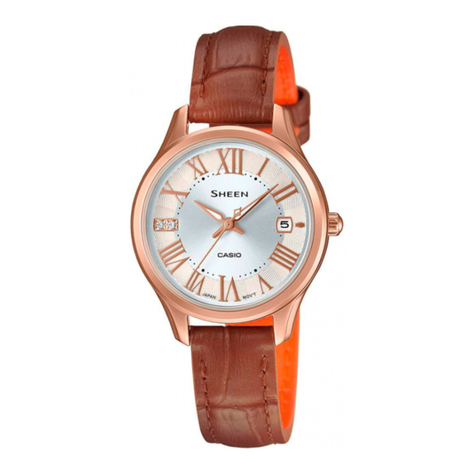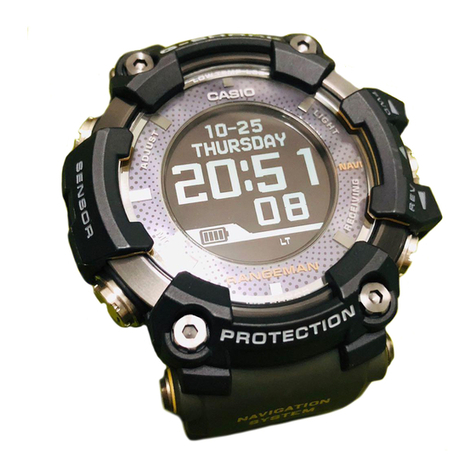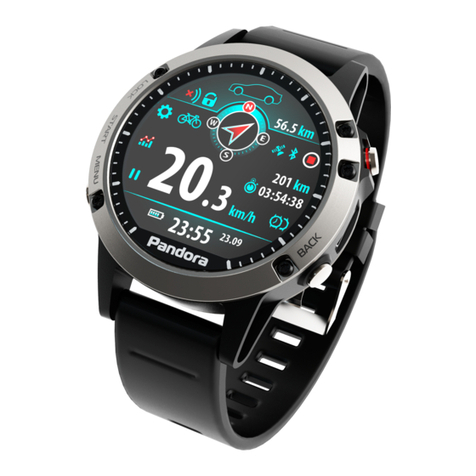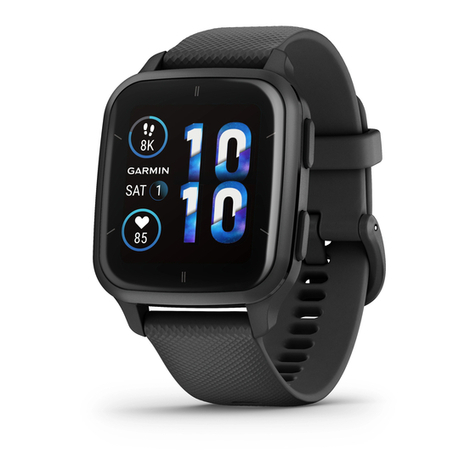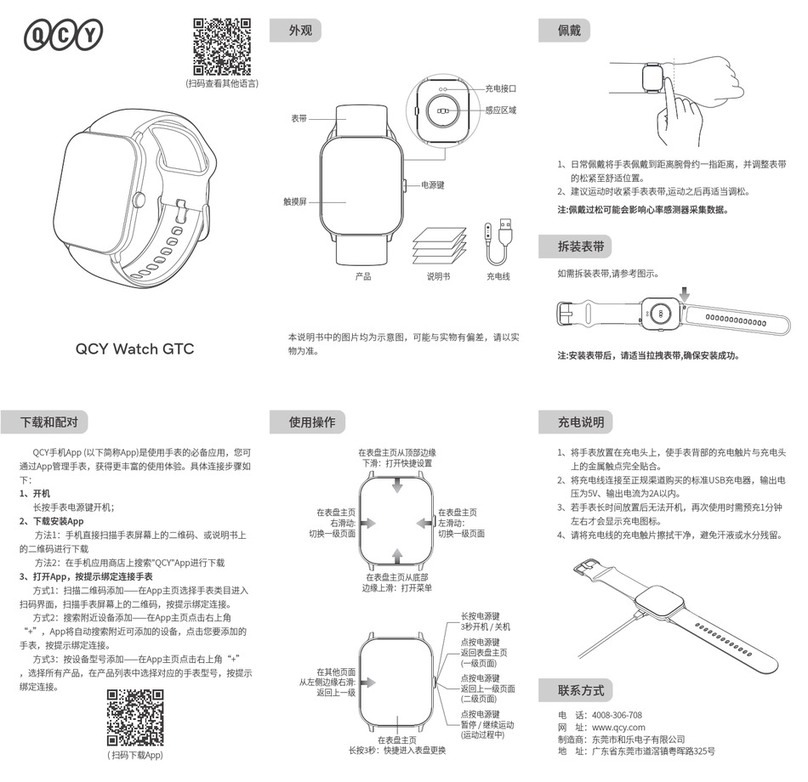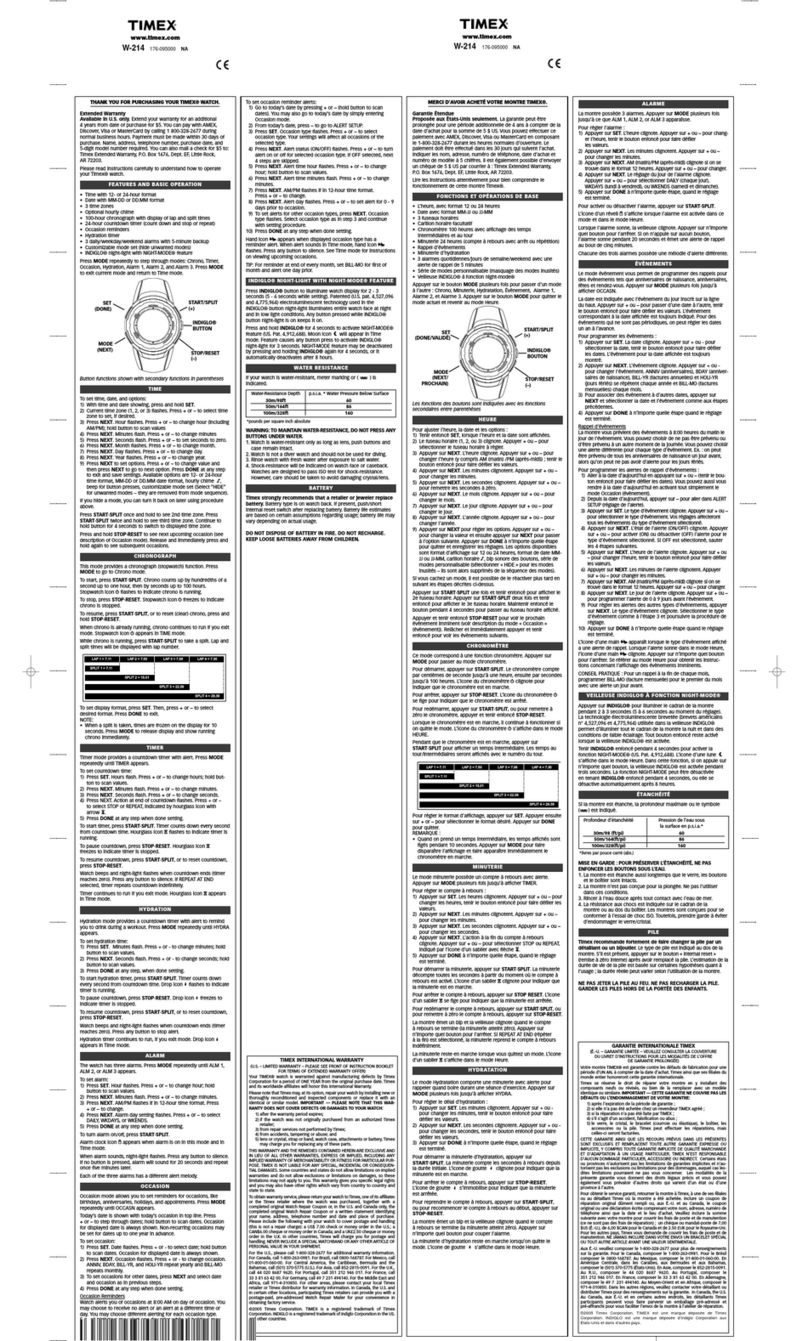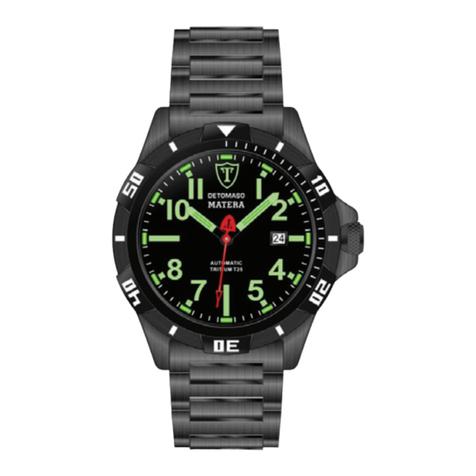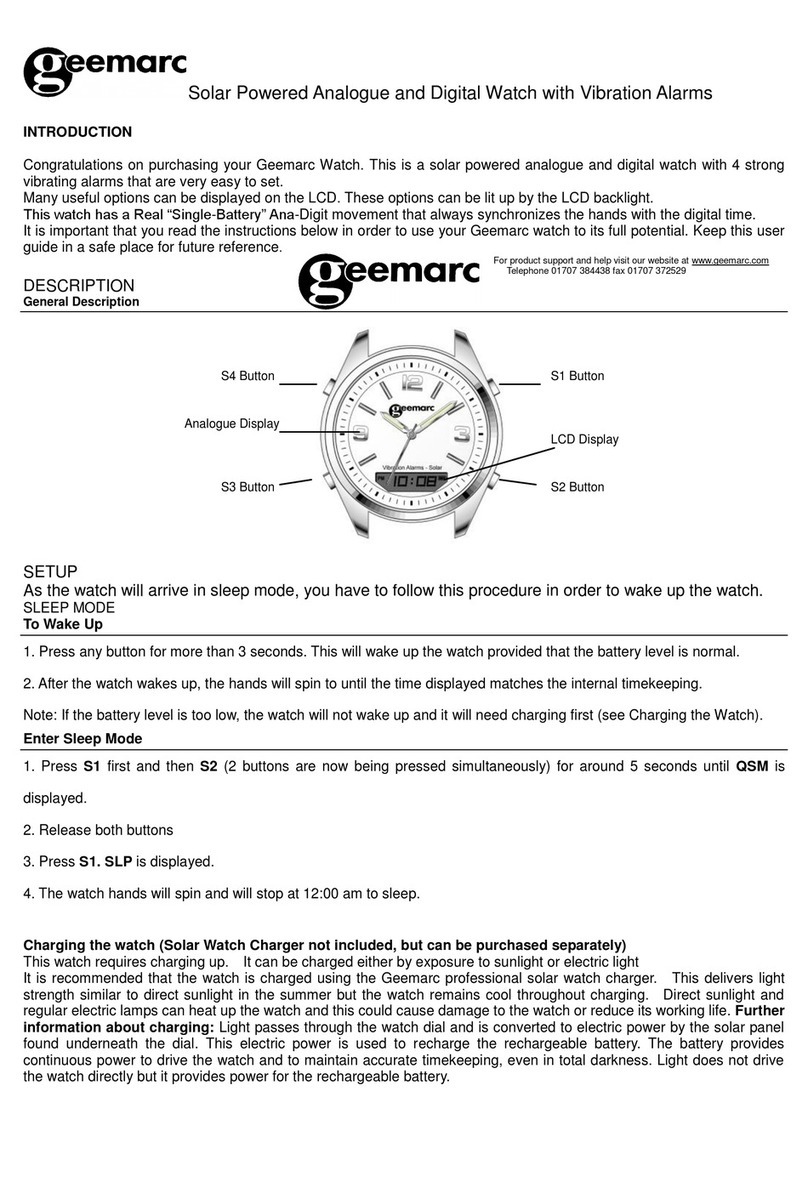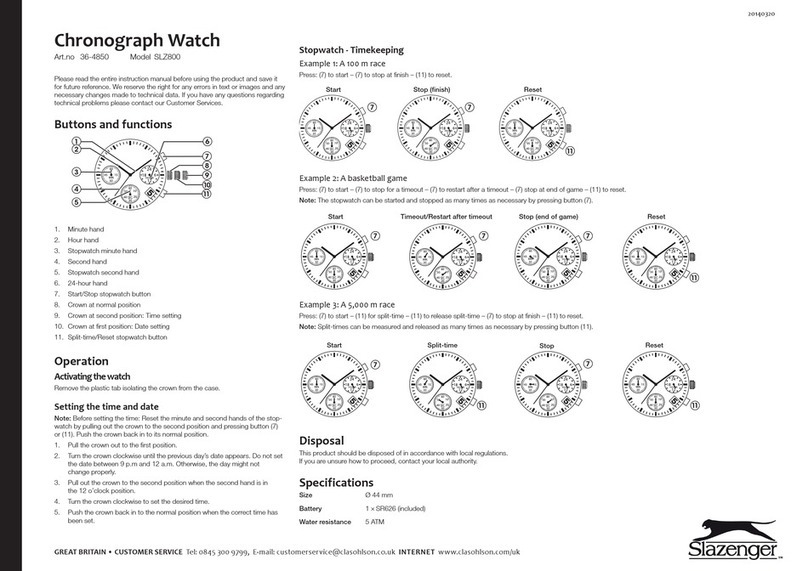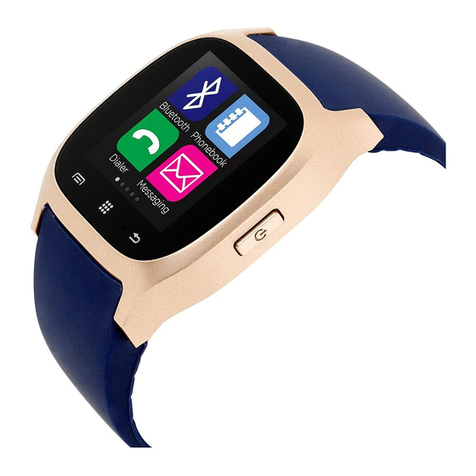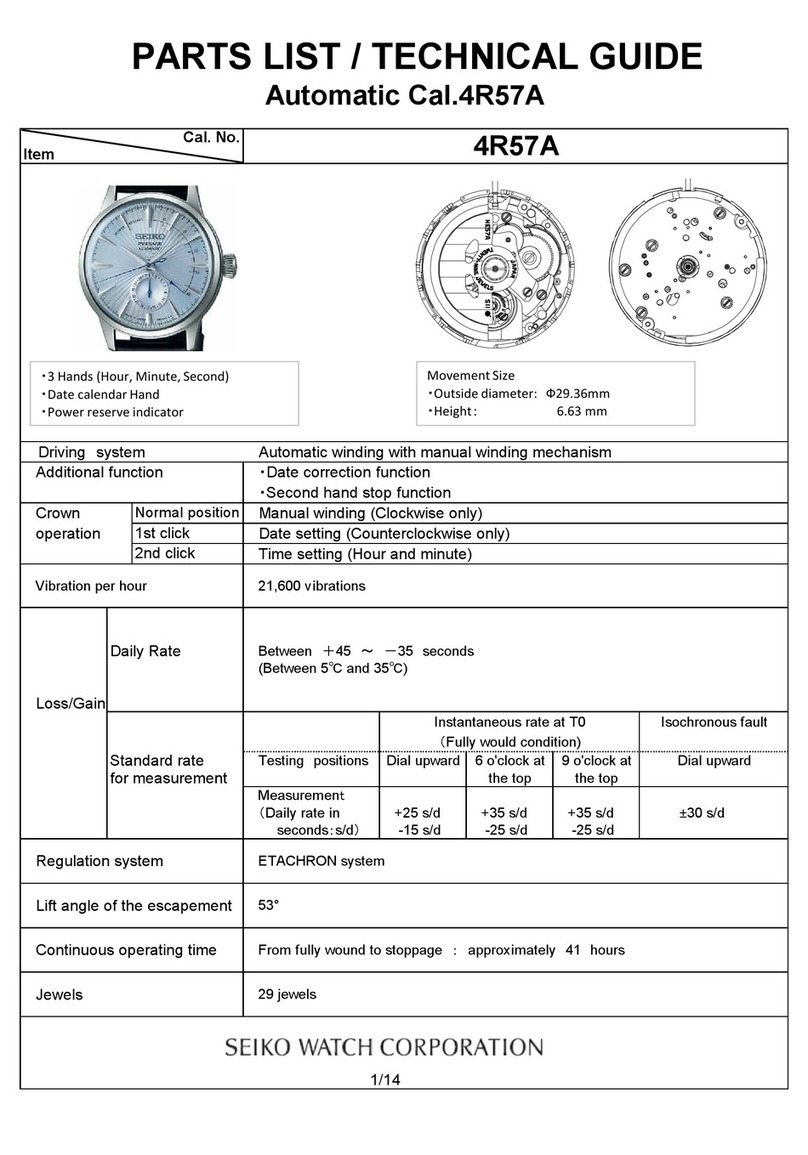
—4 —
(3 times) Seconds
Calibration Signal Reception
Precautions
•Auto reception can be performed while the watch is in the
Timekeeping Mode or World Time Mode only.
•When a time calibration signal is received, the watch corrects its
digital time setting first, and then adjusts the analog time setting
accordingly. In order to ensure that the analog time matches the
digital time, make sure you adjust the analog time to match the
digital time before signal reception is performed.
•Pressing any button while auto reception is in progress will cause
the watch to beep and then exit the receive operation.
•Make sure you are within the range of the calibration signal
transmitter before performing the reception operation. Remember
that geographic contours, nearby buildings, seasonal conditions,
the time of day, can even make reception impossible even when
you are within range of the transmitter.
•Proper reception may be impossible if there is something blocking
the signal. If reception is unsuccessful, try again.
•This watch is designed to adjust its current time setting in
accordance with the calibration signal transmitted in Japan and
the United States only. It operates like a standard (non-radio
controlled) watch outside of the range of the receivable time
calibration signal transmitters.
•When the watch is unable to adjust its time signal using the
calibration signal for some reason, timekeeping accuracy is within
±15 seconds per month.
•Strong electrostatic charge can cause timekeeping error.
•Signal reception is cancelled if an alarm starts to sound while it is
being performed.
•The watch’s calendar shows dates up to the year 2099.
Attempting a receive operation after that causes an error.
Troubleshooting
The watch cannot receive the time calibration signal.
•Is the signal being transmitted?
Though the Japanese calibration signal (Call Sign: JJY) is
continually transmitted by the National Institute of Information and
Communications Technology (NICT) in theory, it may sometimes
be interrupted for periodic maintenance work, or because of
lightening or other problems.
•Are you within the reception range of a transmitter?
See “Reception Range”for information about areas where the
watch can receive the signal.
•Is there something in the immediate area that may be interfering
with reception?
Even if you are within the reception range of a transmitter, objects
between you and the transmitter or electrical noise can interfere
with reception. Avoid such areas during signal reception. See
“Location”for more information.
•Do you have the correct Home City code selected?
Remember that auto receive is not performed unless TYO
(Japan), NYC (New York), CHI (Chicago), DEN (Denver), or LAX
(Los Angeles) is selected as the Home City. Select the correct
Home City code using the procedure under “To configure home
time settings”.
•Is auto receive turned off (OFF)?
Use the procedure under “Configuring Auto Receive Settings”to
turn on auto receive.
•Is the watch in any mode other than the Timekeeping Mode or
World Time Mode during the auto receive times (midnight, 2:00
a.m., 3:00 a.m., 4:00 a.m., and 5:00 a.m.)?
Auto receive is performed only when the watch is in the
Timekeeping Mode or World Time Mode. It is not performed if the
watch is in any other mode.
Time calibration signal reception is successful, but the hourly
time signal and current time are slightly off.
•After the watch receives the time calibration signal, it performs an
internal decoding process before updating its time setting.
Because of this, the time setting may be slightly off (within one
second).
Time calibration signal reception is successful, but the current
time is one hour fast.
•Do you have summer time (DST) turned on (ON)?
Use the procedure under “To configure home time settings”to turn
off summer time.
Time calibration signal reception is successful, but the current
time setting is wrong.
•Is the correct city code selected for your Home City?
If you are in Japan, you should have TYO selected for your Home
City. For other areas, select the correct Home City code using the
procedure under “To configure home time settings”.
The auto receive ON/OFF settings don’t appear when
configuring auto receive settings.
•Auto receive ON/OFF settings do not appear on the display
unless TYO (Japan), NYC (New York), CHI (Chicago), DEN
(Denver), or LAX (Los Angeles) is selected as the Home City.
Use the procedure under “To configure home time settings”to
select your correct Home City.
The auto receive AUTO, 40, and 60 settings do not appear when
configuring auto receive settings.
•The AT, JP40, and JP60 transmitter selection mode options are
available only when TYO (Tokyo) is selected as the Home City
code.
Use the procedure under “To configure home time settings”to
select your correct Home City.
What time is auto receive performed?
•Auto receive is performed in the middle of the night, when
reception conditions are best.
Before going to bed at night, place the watch near a window, with
its 12 o’clock position facing in the general direction of the
transmitter.
How can I perform manual receive?
•Hold down the lower right Dbutton for about two seconds.
The watch will beep to indicate that manual receive has started.
Place it near a window, with its 12 o’clock position facing in the
general direction of the transmitter.
How can I view the last reception date and time?
•In the Timekeeping Mode, press the lower right Dbutton.
This will display the date and time that the time calibration signal
was last received successfully. To return to the Timekeeping
Mode, press the Dbutton again.
Pressing the Bbutton in any mode (except when a flashing
setting screen is displayed) illuminates the face of the watch for
easy reading in the dark.
•You can use the procedure under
“To specify the illumination
duration”to configure the
illumination duration as
approximately 1.5 seconds or
3 seconds.
Important!
•The light may be difficult to see if you turn it on under bright
sunlight.
•If you press a button that sounds a confirmation tone to sound or
if an alarm operation starts while the face is illuminated,
illumination will turn off.
•Illumination is disabled while a manual time calibration signal
receive operation is in progress.
■ To specify the illumination duration
1.
In the Timekeeping Mode,
hold down the AA
AA
Abutton
for about two seconds.
•This will cause your city code
to flash on the display.
Face Illumination
City Code
•Check the auto signal reception setting whenever you have
problems with signal reception or when the time setting produced
by signal reception is incorrect.
•The initial factory default configuration of the reception settings
are shown below. You do not need to change these settings if
you use the watch in Japan.
Auto Receive
Home City
Summer Time
Tokyo
Auto Japan transmitter select
(40kHz/ 60kHz)
Auto switching in accordance
with signal data
2.
Press the CC
CC
Cbutton three
times to display the
flashing seconds count.
3.
Press the BB
BB
Bbutton to
toggle the illumination
duration between about
1.5 seconds ( indicator)
and 3 seconds
( indicator).
4.
After the setting is the way you want, press the AA
AA
A
button to exit the setting screen.
•The watch will also exit the setting screen automatically if you
do not perform any operation for about two or three minutes.



